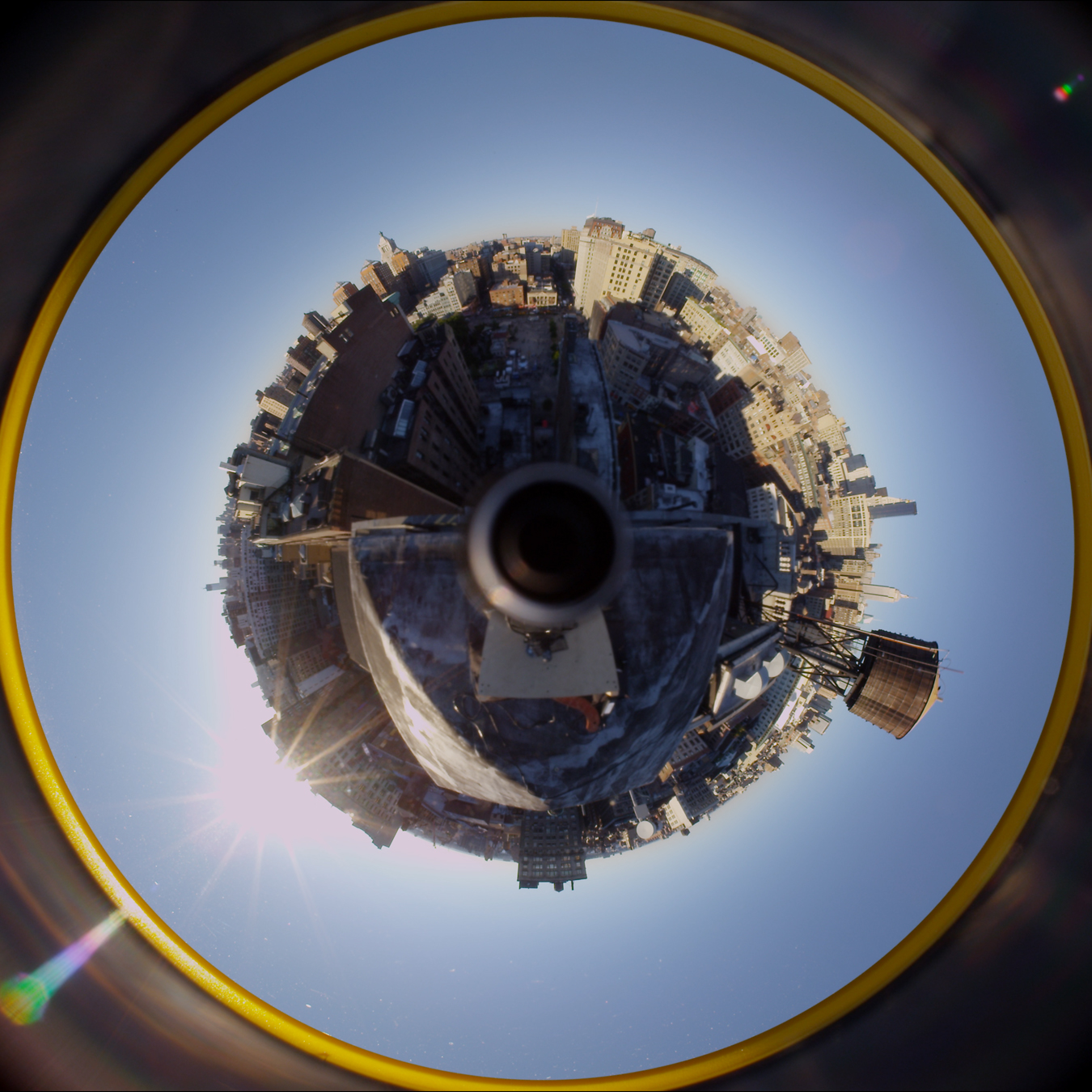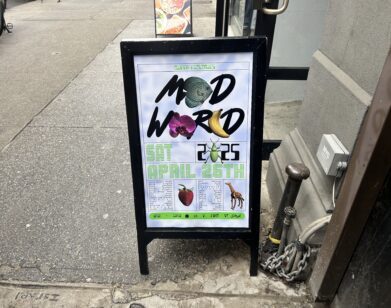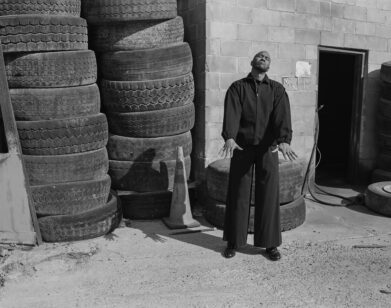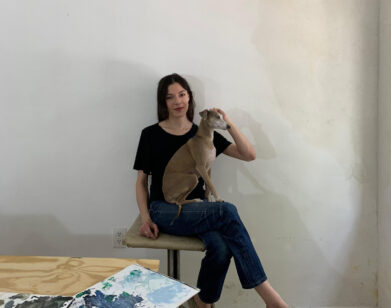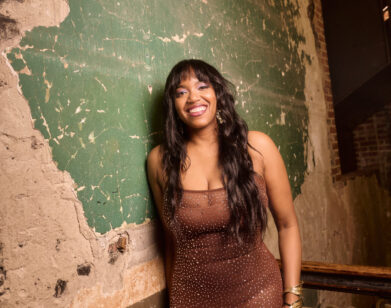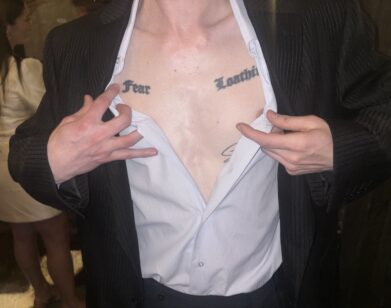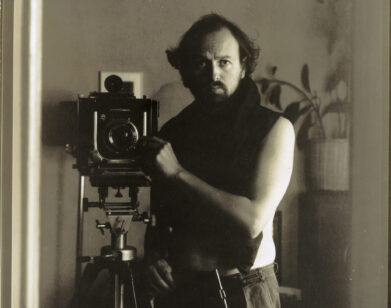T.J. Wilcox
This is what we all do as we pass through the city every day. We’re all making a movie about New York City with our eyes and our mind in real time. T.J. Wilcox
North is the Empire State Building. Northeast is Gloria Vanderbilt. East is Antonio Lopez. West is the once-a-year phenomenon of Manhattanhenge. South is September 11. This month, 47-year-old artist T.J. Wilcox presents his epic multidirectional New York film project “In the Air” at the Whitney Museum of American Art. Using a 360-degree screen that requires 10 projectors, Wilcox takes the striking city panorama from the roof of his penthouse studio in Union Square as the subject of his latest work.
In September 2012, he mounted a 4GoPano camera above his 17th Street studio and captured sunrise to sunset in the round. This footage will play on all 10 projectors, sped up to a half hour—the diurnal lifespan of Manhattan that Wilcox witnesses every day. Within that duration, six different personal films will successively play somewhere along the cityscape, each based on a distinct memory or idea triggered when looking in a particular direction from his studio windows. Some are historical, such as Wilcox’s meticulous model set of the top of the Empire State Building as a landing site for 1930s zeppelins; others are hagiographic, like the silver Mylar balloons that Andy Warhol hung from his Factory windows to welcome the pope in 1965. In every case, Wilcox’s films convey the emotional and psychological landscapes that settle over the spires and avenues of a city after having lived there so long—an invisible compass of past lives. Wilcox, who grew up in Seattle and moved to New York in 1983, is one of the rare artists working today who manages to merge fact with fiction, the highly personal with the historic. A haunting, low-lit poetry exudes from his film works in particular, whether his screens capture swans on tranquil water or the funeral of Marlene Dietrich. One of his earliest friends—and occasional roommate when he first moved to Manhattan—is painter Elizabeth Peyton. This past spring, she made her way to Wilcox’s studio, and spoke with him about his ode to the city as she took in the view.
ELIZABETH PEYTON: Let’s start with what led you to want to make a film about New York.
T.J. WILCOX: Well, I first fell in love with the idea of New York as a kid. New York meant everything to me. It was the epicenter of American music. And it was urbane and sophisticated and intelligent, which my suburban life wasn’t. I wanted the most urban life because my suburban life wasn’t working for me, so I went to the extreme opposite. And as I got older and read magazines like Interview from afar, I saw that it was where Andy Warhol lived, and that was like the end-of-the-rainbow place for me. And to be honest, I still believe that about New York. It hasn’t faded or dimmed for me. It’s fantastic to have a dream about a place and to have had it come true, you know? I’ve lived my whole adult life here, and then suddenly I got this studio on top of a building in Union Square—
PEYTON: Where we are sitting now.
WILCOX: Yes, and it’s right across the street from the apartment I lived in for years. I was actually about to leave this building because the studio spaces are so small, but the super said, “You can’t leave. You’re always here.” [laughs] He said, “There’s a really special space I want you to see.” The penthouse had become available. I never knew it was here because there’s no penthouse button in the elevator.
PEYTON: We had to take some private staircase to come up here.
WILCOX: It was a shock to find. And I like the idea of a penthouse. I had visions of Noël Coward.
PEYTON: It’s very special, although it’s not really Noël Coward. But the view is epic.
WILCOX: I always say it’s more the Unabomber shack than Noël Coward. It’s essentially a crazy, little house on top of a building that seems like someone made it over a series of weekends with whatever leftover construction materials they had. It’s very cobbled together, rambling, almost episodic. And it’s totally isolated. No one else is up here, so it has terraces all the way around. Okay, terraces is the wrong word. Roof! The minute I walked in the door, I was completely sold. I told the super, John, “I’ll take this space and I’m never leaving this building and I want to be here forever.” I think the fact that this place is such an anomaly, built before building codes, so much taller than anything else in the neighborhood, had a lot to do with the decision to make the film from right here. It has a 360-degree view of New York City. The views are almost overwhelming. When I first signed the lease, I came up here and just stared out—
PEYTON: Mesmerized.
WILCOX: Yeah, and I thought, Maybe I’ll never make art again. I just kept going from window to window looking in every direction. But as I looked east or west or south, I started to remember things that had happened to me in different places, because I’ve spent more than 20 years in the city. So I have memories radiating from every sight line in this studio. I seemed to be haunted or attached to all of these memories related to each direction. Like, over there is where that terrible date of mine ended, or over here is where I had a first kiss, or this is where a character in a novel lived, or this direction was a favorite scene from a movie. I became really interested in that idea of looking at this view in the present and past tenses simultaneously. It was all so richly layered.
PEYTON: I was just thinking today that buildings are like trees; they’re around for much longer than we are.
WILCOX: Yes, but even if the imagery doesn’t change, the view does between the times you look at it because of all of the experiences that have come between. And I think that that’s a part of artwork that people don’t necessarily know about so much—that very often the studio itself, the structure of the studio, the physical reality of an artist’s studio, really plays a major role in the work that comes out of it. I was fascinated when I went to see Jackson Pollock’s house in East Hampton. I went upstairs to the bedrooms, which he used as a studio before he had the money to renovate the barn. And the first drip paintings that he made are exactly the size of the floor of the upstairs bedroom. He would stretch canvas from wall to wall to wall to wall, and so they’re the size of the guest room.
PEYTON: Limitations can be so fertile for creativity.
WILCOX: It gives you something to work with or against, or just to build on. I started to think about that after I got over this spectacular view: The view itself is the amazing attribute that the studio has. Studios don’t typically have great views. So it was my chance to use it to grapple with a city I’ve lived in most of my life.
PEYTON: You’ve made a panorama of your studio through several films, all of them so different. You wanted to incorporate that immersive, surround experience in the viewing of the piece.
WILCOX: It takes six projectors to make a 360-degree image, so those projected images all line up side by side. If it were on a flat screen, it would be a big, wide, long projection, but because it’s being contained by a circular screen, it wraps all the way around you. We shot the panorama film on the roof of the studio. So you see the view of New York City that I see every day in the round. We shot it in a time-lapsed way so you’ll see it over the course of dawn to sunset in a half hour. Then each of those six projectors has it’s own individual story to tell—a story from the direction it’s facing.
PEYTON: You have a model of the Empire State Building in your studio right now, and all of these miniature zeppelins. This is the film for the north direction.
WILCOX: It tells the story of how the top of the Empire State Building was originally intended to be a mooring mast for blimps that were traveling from Germany to the United States and back. It was this great modern idea of the future.
PEYTON: It’s amazing that people thought that, of course, that’s what the top of the Empire State Building would be used for.
WILCOX: The designers actually talked about it in these brilliant optimistic terms, like it made perfect sense. You dock, and then here’s the really scary part: you walk down a gangplank …
PEYTON: 102 stories above Manhattan.
WILCOX: Yes, literally! [laughs] You just go down a gangplank, you pass customs in the round tip of the building where there’s now the observation deck, and then you get in the elevator, go down, and get into a taxi. It was an amazing idea of the future. It used to take a week or two to get here by boat.
PEYTON: Such faith in technology. And the future. You did a Gloria Vanderbilt film for northeast. Another film, for south, involves the super, John, talking about being here on the roof on the morning of 9/11.
WILCOX: John told me his story of seeing the building collapse when he was showing me this space.
PEYTON: So you filmed him up here talking, just telling this story?
WILCOX: Well, not that first time. I made him do it again. He’s a real New Yorker, born and bred. I love that his name is John, and he always wears this blue shirt with his name embroidered above the pocket. He inherited the job from his father. He has spent his entire life in this building because he has great affection for it. I like being here too, so that’s why he and I have kind of connected.
PEYTON: Well, you’ve gotten him so many artists for this building.
WILCOX: I have!
PEYTON: Everyone trusts your taste.
WILCOX: I don’t know about that … But we were standing on the roof, and in the south the space opens up into a kind of deck. He said, “Every time I come up here, I remember September 11.” He said that, by chance, he was up here working that bright September morning—they were doing some repair to the wall—and he saw the planes pass overhead and said to his assistant, “That’s strange, they’re flying so low.” Then they went back to whatever they were doing. And then, of course, a few minutes later, he saw the impact and spent most of the rest of the day just kind of glued to the spot. He stayed up here the whole day, transfixed. He used that word that I find so perfect. That day was so crystal clear.
PEYTON: That day was so beautiful. Almost early fall.
WILCOX: The atmosphere that day is apparently described as “severe clear.” September 11 was the day of severe clear, which makes it sound more ominous. He could see so far that he saw people in the buildings.
PEYTON: When I look south outside of your studio now, I can see the new Freedom Tower.
WILCOX: It’s called the World Trade Center. I refuse to call it the Freedom Tower. I have to say, watching it growing as I have, particularly in the late afternoon when you see the facets of the building, I’ve started to appreciate it.
PEYTON: I like it. I think it’s pretty.
WILCOX: John’s description of that day is so moving and matter-of-fact. He’s a real tough New York super, and his story felt, to me, very elemental, unembellished, sincere, and heartbreaking.
PEYTON: He was seeing it in a way that many people did not see it. He was seeing it in an unframed way. Most people were seeing it with a narration.
WILCOX: Those firsthand accounts in New York City at the moment seem, I suppose, plentiful, but whenever you’re working with the moving image or recorded images, it can easily become so precious.
PEYTON: I get a feeling that the whole project is about containing history and memory. Another film you have involves Antonio Lopez, the fashion illustrator. I know you heard about him when you were a teenager and imagined what New York was like. That’s part of what brought you here, although that New York was fading away by the time you arrived in 1986. In a way, it’s also a view of something that is not here anymore, like the Twin Towers.
WILCOX: Since we’re talking for Interview, it’s worth noting that Antonio was a great friend of Andy Warhol. I think that Antonio might have even introduced Warhol to the Polaroid camera. And Andy was a fashion illustrator as well, although Antonio become the most successful fashion illustrator. Andy really admired and appreciated and understood that what Antonio was doing was much more than just making drawings of dresses to help move the merchandise. Antonio, for example, is credited as being the first person who used anyone of color in his drawings, which may not sound like much now, but was incredibly radical at the time. He was looking at the world around him. He was really somebody who had a great sense of the evolution of style. He would meet amazing people in his life, whether they were out dancing together or walking down the street. He would invite them back to his studio. So he was drawing the kids of his time, of his generation, and not these archetypes of fashionable characters who were very patrician. I grew up in Seattle, and I had a friend in high school who came to New York to be a model. She just had no success at all, nobody wanted her because her look was very modern and very unusual. They finally sent her to an open casting call at Antonio’s studio, and out of all of these girls, he said, “That’s the one.” It started her whole career. She came home bubbling over with these stories of this amazing man. She had books of his work that we started looking at, and it turned out he had done that for many girls throughout his career. He was just out one night in the ’70s dancing when he met Jerry Hall. He discovered Grace Jones, Jessica Lange, Tina Chow … He was ahead of the curve. But from those images, I started really thinking about New York City. And not long after I got to New York and was living with my model friend, she was suddenly going to his memorial service. [Peyton gasps] He had died of AIDS. It really felt like the end of an era at that moment when I arrived in New York. There was just so much death around us and it was a weird time to be a kid.
PEYTON: When I moved here in 1986, it was just so unknown what was happening. That’s the moment we left our parents’ house, and then it all became so frightening.
WILCOX: That was a huge part of my coming to New York. Art school was the beard. I was coming to New York City to have sex, go to clubs, be free, and have this wild life. The minute we got here, it was like, “Yeah, you don’t get to do that; it’s just not an option anymore.”
PEYTON: Yeah, it felt so dark.
WILCOX: And then a little while later Warhol died. But happily, I met you, and we did something else. We created a life and we lived our own way. Things do mutate and carry on.
PEYTON: It was like a war was going on, because it wasn’t being acknowledged and it wasn’t being attended to. It seemed a moment for exposure to the worst sides of humanit—people not caring while others are dying.
WILCOX: When I used to go home to that apartment that I shared with my model friend, it was in the Flower District area. It was a beautiful art deco building, but in those days the streets were so desolate at night and there were a lot of prostitutes around Penn Station. I didn’t understand at first what all the little plastic vials were in every crack in the sidewalk. Of course, I came to understand that they were crack vials.
PEYTON: That was going on at the same time.
WILCOX: So in terms of Antonio, I was looking at a book of his Polaroids—he would take pictures of the people he invited up to his studio, and he would often cast these kids he saw break dancing in Union Square because they were from the Bronx, like he was—and I started noticing the backgrounds in the pictures. He often had them stand against the window. I realized that his studio view was exactly the same view outside of my studio window. And it turns out that his studio was next door to my studio and at the same story.
PEYTON: Oh my gosh.
WILCOX: It turned out his studio was in this very building!
PEYTON: What a coincidence.
WILCOX: It felt like a ghost passed through the room or something. I love looking out the same view and thinking he was alive and loving New York. He was seeing exactly what I enjoy seeing every day. It feels like we have this tenuous but real connection through New York that we share across time, so I wanted to make a film about that discovery.
PEYTON: Do you think of this piece as autobiographical?
WILCOX: Out there in the city there are eight million different New York stories, and these films are six stories of the stories I have about New York City. It’s not just a portrait of my looking. This is what we all do as we pass through the city every day. We’re all making a movie about New York City with our eyes and our mind in real time and remembering it. So I think of it as an invitation almost, or a retrospective of everyone’s experience of New York City.
PEYTON: I imagine that’s what will happen when people watch the projection. They will start telling stories to each other. We have a lot of stories from our years together.
WILCOX: Do you remember meeting me? I remember meeting you.
PEYTON: I remember seeing you on the other side of the row in Brian Wallis’s postmodern class at SVA and thinking you were the most beautiful, cool boy I had ever seen. I thought you’d never talk to me, and then we became such close friends. [Wilcox laughs] We lived on East Second Street together, and it was very scary.
WILCOX: We had no money! But what we did have was access —
PEYTON: To alcohol? [laughs]
WILCOX: Yeah! We had alcohol, but we had these great cheap apartments, and we also were able, with a friend, to rent an unrenovated apartment in the building that we could use as a studio. The whole building was really open.
PEYTON: It was literally open, like the walls were open to the apartment next door.
WILCOX: But it also had access to the roof, and so in the summer, when we couldn’t go anywhere, we would go up to what we called our tar beach.
PEYTON: We’d have so many parties up there.
WILCOX: We had so much fun on that roof. We didn’t need anything. We didn’t need a fancier beach. We loved our tar beach.
PEYTON: I was just thinking about being affected by the history of that time. I mean, we were just living it with unformed thought. Then we ended up living in different apartments in the same building on East Second Street and Avenue C, and what would we do with our time? We’d be sitting on the couch talking about Marie Antoinette! [laughs] About her carriage or something so different from the surroundings we were in. We were talking a lot about literature then.
WILCOX: We read Dostoyevsky together in my tiny little apartment … or your tiny little apartment!
PEYTON: While people were being murdered outside. Which was not an unusual event.
WILCOX: The club world that was on Second Street and Avenue D … We lived between C and D, and it would be really loud, like boom! boom! boom! through my wall. And we were inside discussing Stendhal and The Red and the Black having tea or something. Tea and vodka probably.
PEYTON: I had to leave town so I could move to the west side. I always wanted to live on the west side but I couldn’t figure out how to get out of the East bloody Village.
WILCOX: Well, you’ve done it now.
PEYTON: Yeah. Now it’s like I’ve been on the west side forever.
WILCOX: Thank god. [laughs]
PEYTON: Along with your project, which will take up a room of the Whitney on the second floor, aren’t you also curating a selection from their permanent collection? I think you told me out of 19,000 pieces, you’ve arrived on a few artists.
WILCOX: Yes. Since my piece will hover in a room in the middle of the second floor, they suggested I put together a show from their collection in the galleries around it. I said, “Let’s raid the ice box, absolutely!” I started looking through thousands of works. And they were all so mind-blowing. There’s a reason why they’re in the collection of the Whitney. So it was actually a great treat to kind of get out of my own head and to consider all of this work and to consider what’s really important to me and what I would like to share this space with. Ultimately, I settled on pieces that had to do with the act of looking in a very direct, structural way. I like really precise installations. For example, I’ve always admired Félix González-Torres because he had such a great sense of space, and that, by framing his works properly in space, he could really effect the production of meaning that his work was creating. And I’ve noticed lately when his work gets shown in group shows, it often gets kind of squashed in. I never feel like it’s installed the way I think he might have done it.
PEYTON: Isn’t it written in stone with his work about how much space it needs to take up?
WILCOX: It probably is, but somehow I think he would be even more generous with it than some places allot to it. But in the collection of the Whitney I saw his series of photographic prints he took of footprints in the sand. They are beautiful, undulating shots of the sand. It was this record of these footfalls, this ephemeral trace of the lives that touched the beach.
PEYTON: Who’s been there before. Quite like your film.
WILCOX: I admired what he was doing with that work. And then there is a piece by Yoko Ono called Sky TV that I had seen installed at the Whitney sometime ago. I remember not understanding it when I saw it at first because the day was very gray, and so the TV screen was all gray. I read the wall label, and it turns out that Sky TV is a camera that’s mounted on the roof that’s pointing straight up at the sky. You’re seeing in the gallery a live feed from the roof of the infinite.
PEYTON: That’s so nice.
WILCOX: It’s so beautiful. I thought it would be really amazing to have their work together because they both use these elemental things, the sand and the sky, so profoundly. I thought of it in terms of how wonderful it would be to have Felix’s looking down and Yoko’s looking up, in different directions.

